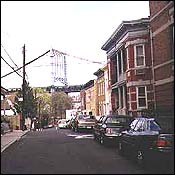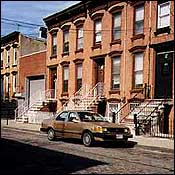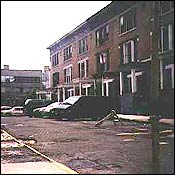
Astoria, Queens
2003*: $650/1200 (Studio/1BR)
2005: $850/1200
What we found: 1BR on 30th Ave., a third- floor walkup in a rent-stabilized building with hardwood floors and new renovations and appliances, $1150; two-room studio on Broadway, $1100. (Broker: Marathon Realty, 718-267-7272)
Bargain hunting: The farther you get from the popular Broadway strip, the cheaper the apartment.
Building styles: Walkups, private homes.
Pros: Plenty of cafes and coffee shops, young chefs branching out on their own, the Museum of the Moving Image, and Bohemian Hall, a massive outdoor beer garden.
Cons: The neighborhood has been labeled up-and-coming for years, but still isn’t quite there yet.
Commute to midtown: 15 minutes on the N or W train.
Final verdict: Not as cheap these days, but still a good deal if you want a livable space.
Forest Hills, Queens
2005: $900/1,600 (Studio/1BR)
What we found: 1BR on 76th and Austin, in a pre-war building with hardwood floors and an eat-in kitchen that includes a garbage disposal, $1275. (Broker: Contact Realty, 718-459-5656).
Bargain hunting: The least expensive apartments are usually farther from Austin Street.
Building styles: Co-ops and pre-war buildings.
Pros: Views of Manhattan; Austin Street and its collection of restaurants, cafes, and clothing boutiques; good schools; and an established Jewish community.
Cons: It’s a long, long ride into Manhattan.
Commute to midtown: 30 minutes on the E, F, R, G and V trains, 15 minutes on the LIRR from the Forest Hills station.
Final verdict: Rents have risen for the first time since 2001, and it’s only going to get pricier. Now’s the time to make the move.

Red Hook, Brooklyn
2003: $850/1400 (Studio/1BR)
2005: $950/1400
What we found: 1BR on Columbia St. with a living room, bedroom, and an office, $1050; studio, also on Columbia St., $975. (Broker: Frank Galeano, 718-596-9545)
Bargain hunting: You’ll find cheaper apartments in eastern Red Hook (east of Van Brunt St. and south of Commerce St.). It’s not as pretty as Red Hook proper, but in its favor is popular Valentino Park, right by the water—a good place for dog-walking.
Building styles: Brick townhouses and mixed-use walkups, above storefronts.
Pros: Cobblestone streets and waterfront views.
Cons: You’ll need your walking shoes or (gasp!) have to take the bus in order to get around.
Commute to midtown: 35 minutes (including 15 min. walk to the F train, or the B-61 Crosstown Bus).
Final verdict: Red Hook is still affordable compared to its surrounding areas (Cobble Hill, Carroll Gardens), but with increasing demand and a waterfront shopping/condo complex on the way, you’ll find better deals farther from Manhattan, perhaps in Sunset Park.
Upper East Side
2003: $1,150/3,100 (Studio/1BR)
2005: $1,200/3,500
What we found: 1BR on York in the 80s, with a renovated kitchen, hardwood floors, high ceilings, lots of sunlight, good closet space, and close to Carl Schurz Park and the East Side ferry service, $1375.00. For the daring, or just plain broke, we found a studio on 68th and Madison with a shared bathroom in the hallway, a kitchenette, and a 6x13 foot living room, $562. (Broker: Lettieri Realty, 212-744-4190)
Bargain hunting: The best bargains are walk-ups on York and First Avenues, especially in the 90s.
Building styles: Old-style tenement buildings, high-rises.
Pros: Close to boutiques and shops, restaurants, high-end grocers, museums, and the East River esplanade, so you can bike, run, or walk as far north or south as your feet will take you.
Cons: York and First Avenues are a considerable distance from the subway.
Commute to midtown: 20-35 minutes on the 4, 5 or 6 trains.
Final verdict: As long as the Second Avenue subway remains a theory, the Upper East Side remains surprisingly affordable, especially if you venture all the way east, to the river.

Washington Heights
2003: $700/1,800 (Studio/1BR)
2005: $800/1,400
What we found: A two-room studio on Bennett and 191st Sts on the fourth floor of an elevator building, with an eat-in kitchen and separate living room, $1050. (Broker: Stein-Perry Real Estate, Inc., 212-928-3805.)
Bargain hunting: The best deals are east of Broadway on Wadsworth and St. Nicholas Avenues. The more adventurous should head farther east to Amsterdam Avenue, where gentrification hasn’t quite hit and the rent is up to $200 cheaper.
Building styles: Brownstones, pre-war buildings with high ceilings and hardwood floors.
Pros: Open-airy views, Bennett Park, Fort Tyron Park, The Cloisters, and a burgeoning bar and restaurant scene.
Cons: You’ll have trouble getting your downtown friends to visit.
Commute to midtown: 15 minutes on the A train, 30-40 minutes on the 1 and C trains.
Final verdict: Rents have been rising in the past year, but are holding steady now, so jump on that great deal while you can.
Street Smarts: Tips on finding a cheap apartment >>>
Street Smarts
Consider the size and layout, not the name. Often studios are more spacious than one-bedrooms.
Don’t judge an apartment by its photos (or lack thereof). Some of the best apartments come with the most pathetic photos. See it in person before you say no.
If you’re set on a certain neighborhood, walk the streets. Get to know building owners and supers. They’re the ones who know if and when apartments are opening up. If you luck out, you also avoid a broker’s fee. So if you’re interested in a certain building, it’s worth stopping by their management office.
Don’t lock yourself in with one broker. Brokers have different listings, so working with more than one widens your options.
Be firm about what you want. Don’t let a broker refocus your search or sell you short. There are deals to be had, and they can be yours if you make your broker(s) look hard enough.
Investigate your landlord. Having a responsible landlord is critical. Find out if the building’s well taken care of—if the basement is overflowing with garbage and painted over with graffiti, chances are no one’s going to be running to your rescue when your toilet overflows. Knock on a few doors and speak to people that live there, and ask about the heat, the pipes and water pressure, and whether the super’s responsive to their needs.
The time of year matters. In the summer, more apartments open up, but the competition is greater, and you can run into a bidding war (know your ceiling). In winter there are fewer options, but there aren’t as many people looking, so landlords may give you a better deal, including incentives like one month’s free rent, or, in Peter Cooper/Stuy Town, a free iPod or large-screen TV.
Have your paperwork ready. When you’ve found the right apartment, you don’t have time to lose. Have the following in hand: the first two pages of your tax returns from the previous two years; a completed financial statement detailing your assets, liabilities, and income; references from previous landlords and possibly your employer; and certified checks in increments of $500. In New York City’s nutty real estate market, dream apartments have been snatched away before!
*Based on data collected from a 2003 cover story in New York Magazine.